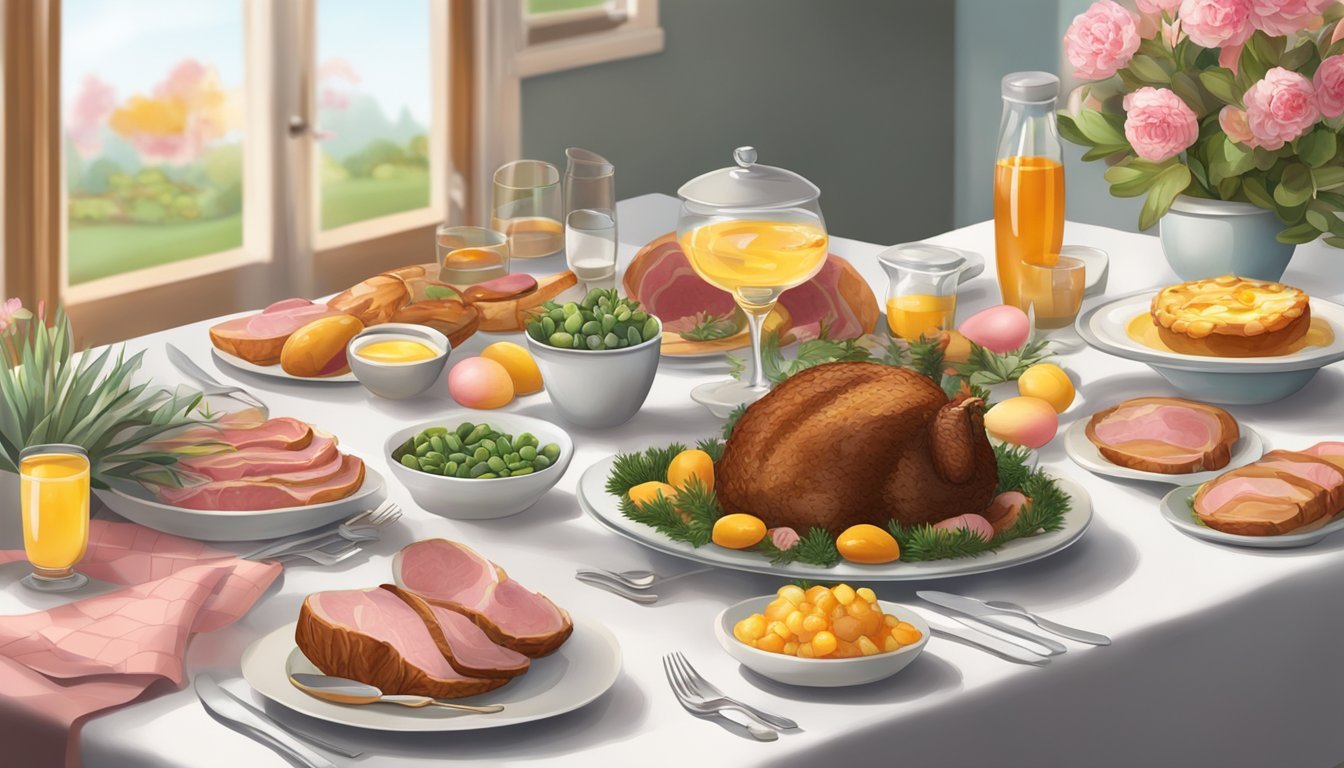Lamb or Ham
Deciding on the Perfect Easter Feast Main Dish
As Easter approaches, deciding on the perfect main course becomes essential for a memorable celebration. Both lamb and ham are traditional favorites that have graced the Easter dinner table for generations. Lamb often symbolizes the start of spring and is associated with Easter due to its religious significance, signaling renewal and new beginnings. On the other hand, ham is a favorable choice for its rich flavor and the convenience of serving large gatherings, as it is often cured and cooked ahead of time.
When planning an Easter dinner (What wine goes well with dinner?), it's important to consider the preferences of your guests. A well-prepared leg of lamb, seasoned with garlic and rosemary, can offer a show-stopping centerpiece for those who enjoy its distinct, rich flavor and tender texture. Meanwhile, ham can be glazed with a variety of ingredients such as brown sugar, honey, or even Coca-Cola to achieve a balance of sweet and savory notes, appealing to a wide array of palates.
For those seeking alternatives, there are numerous non-traditional main courses that can be just as festive and satisfying. Seasonal spring vegetables, fresh herbs, and lighter proteins like salmon, incorporated into the menu, can cater to diverse tastes and dietary preferences. Offering a balanced menu that includes both meat and vegetarian options ensures that every guest experiences the joy and abundance of Easter.
Choosing the Right Main Course
Selecting the perfect main course for Easter dinner is crucial for creating a memorable meal. Whether you're following traditions or looking for the ideal meat to serve, this section guides you through various options including traditional meats like lamb and ham, as well as alternatives for those with dietary restrictions.
Understanding Easter Traditions
The main course for Easter is steeped in tradition, with lamb being a frequent choice. Easter lamb often symbolizes the beginning of spring and holds religious significance for many. Lamb can vary from lamb shanks to a boneless leg of lamb, and the preparation may involve a flavorful lamb rub or glaze.
Benefits of Lamb as Easter Main
Lamb offers a rich, festive flavor well-suited for special occasions. The meat's tenderness and ease of preparation make it an excellent choice for those looking to impress. Using a meat thermometer ensures the lamb is cooked perfectly. A succulent Easter lamb, seasoned with herbs and spices, can become the highlight of your Easter dinner.
Advantages of Serving Ham
Ham, especially varieties like baked ham or spiral ham, is another traditional Easter favorite. Its advantages include a wide array of preparation methods, easily serving large groups, and the presence of a bone-in ham which retains moisture and flavor. Preparing a glaze, perhaps featuring cinnamon, soy sauce, or clove, lets hosts personalize their Easter ham.
Alternative Easter Mains
For those who may want to diverge from tradition, there are other enticing options such as:
Prime rib: Rich and indulgent, suitable for a feast.
Roast chicken: A classic alternative that's both universally loved and easier to prepare.
Air fryer lamb chops (What wine goes well with lamb chops?): A modern twist on traditional lamb.
Salmon: A lighter option for those preferring fish.
A savory pot roast: Hearty and comforting.
Considerations for Dietary Restrictions
Easter dinner can still be inclusive for guests with dietary preferences or allergies. Alternative mains to accommodate different needs include:
For vegetarians: Lentil loaf or stuffed bell peppers.
For vegans: Vegan roast made from seitan or legumes.
For gluten-free guests: Ensuring the main dish and accompanying sauces or gravies are free from gluten-containing ingredients.
Preparing Your Main Course
When preparing your Easter main course, consider the following steps for optimal results:
Season your choice of meat, whether it's lamb or ham, with a suitable rub or glaze recipe.
Cook to the recommended internal temperature using a meat thermometer.
Rest the meat before carving to ensure it retains its juices for maximum flavor.
Choosing the right Easter main will depend on your preferences, traditions, and the dietary requirements of your guests. With a bit of planning, you can select a main course that is both satisfying and special for everyone at the table.
Complementing Your Main with Side Dishes
Selecting the right side dishes enhances the flavors of your main course, whether it's lamb or ham. They provide balance, variety, and help cater to different dietary preferences among your Easter dinner guests.
Classic Easter Side Dishes
Classic side dishes are staple companions to the main course. For lamb, rosemary-infused Dauphinoise potatoes offer a creamy texture that complements the rich flavors of the meat. A side of green beans almondine adds freshness with a crunchy finish. Serving ham calls for sides like a sweet and savory carrot dish or a traditional pasta salad, both highlighting the ham’s smoky flavor.
Creative Twists on Traditional Sides
To refresh timeless recipes, add innovative touches to conventional sides. Transform the classic carrot side by roasting baby carrots with a hint of cinnamon, elevating their natural sweetness. Or arrange a sheet pan of roasted seasonal vegetables for an easy, yet impressive display. For those enjoying Easter brunch (What wine goes well with brunch?), an elegantly set charcuterie (What wine goes well with charcuterie?) board can start the meal with a variety of flavors and textures.
Cold Sides and Salads
Cold sides can offer a crisp and refreshing contrast to your warm dishes. A colorful wedge salad brings a visual and textural diversity to the table with its crisp lettuce, creamy dressing, and crunchy toppings. Opt for a bright Red Potato Salad, flavored with Dijon mustard and accented with pickled red onions, to balance the palate between bites of the main course.
Easter Breads and Rolls
No Easter meal is complete without bread at the table. For lamb, subtly sweet hot cross buns serve as a fitting nod to tradition. When serving ham, provide fluffy homemade rolls or a hearty bread selection. These options are not only perfect for sopping up sauces, but they also double as vehicles for leftover ham sandwiches during Easter brunch the following day.
Appetizers and Starters
Easter gatherings offer an excellent opportunity to start the meal with a diverse array of appetizers (What wine goes well with appetizers?). The starters serve as a prelude to the main course, whether lamb or ham, and are essential for keeping the guests engaged and satisfied.
Easter Appetizer Ideas
For a traditional yet easy-to-prepare appetizer, deviled eggs are a must-have for Easter. Their creamy filling and mild flavor make them a hit across all age groups. They can be simply seasoned with salt, pepper, and paprika or embellished with creative toppings like a smidgeon of salmon roe for an added touch of elegance.
Deviled Eggs: A classic choice seasoned to perfection.
Salmon Bites: Succulent pieces of smoked salmon on toast or crackers, sometimes garnished with dill or paired with cream cheese (how long does cream cheese last?).
Building an Elegant Charcuterie Board
A charcuterie board serves as both an appetizer and a decorative centerpiece. The board can be beautifully arranged with a variety of meats, cheeses, fruits, and nuts. Here is a simple guide for setting up an inviting charcuterie board:
Select Your Meats: Choose a range of textures and flavors, like prosciutto, salami, and pâté.
Add Cheeses: Contrast your meats with soft brie, aged cheddar, and sharp gouda.
Accompaniments: Include olives, pickles, and honey for guests to fine-tune each bite.
Breads and Crackers: Offer an assortment of crunchy crackers and sliced baguette.
Garnish: Spruce up the board with sprigs of rosemary or edible flowers for a festive touch.
The key to an impressive appetizer course is variety, ensuring that there is a little something for everyone to enjoy as they anticipate the main entrée.
Perfect Pairings: Drinks and Your Easter Meal
Selecting the right drinks to accompany your Easter main course can elevate the dining experience for your family dinner. Whether serving lamb or ham, the perfect beverage can complement the flavors and contribute to a memorable feast.
Wine Selection for Lamb or Ham
For Lamb:
Red Wines: A classic pairing with lamb would be a robust red wine. Options like a Bordeaux or a Rioja enhance the rich flavors of the meat.
Pinot Noir: For those preferring a lighter red, a Pinot Noir offers a balance that doesn't overpower the natural flavors of lamb.
For Ham:
Rosé: A dry Rosé is refreshing and versatile, matching well with the sweet and savory nature of ham.
Riesling: A Riesling, with its slight sweetness and acidity, can counterbalance the saltiness of the ham.
Non-Alcoholic Beverages
For All Ages:
Sparkling water with a twist: A splash of lemon or lime adds a festive touch.
Fruit-infused Water: Combinations like strawberry-basil or cucumber-mint are refreshing and can be enjoyed by everyone.
By considering the main entree and the preferences of your guests, you can select drinks that will harmonize with your Easter family dinner, ensuring a well-rounded culinary experience.
Desserts to End the Feast
A memorable Easter feast isn't complete without a dessert table that boasts a variety of sweet treats. Chocolates and traditional Easter sweets often take center stage, but there are numerous recipes that can impress and satisfy all tastes. From chocolate delights to elegant cakes, these desserts add the perfect finale to your holiday meal.
Chocolate and Easter Sweets
Easter and chocolate are a classic duo, with chocolate eggs and bunny-shaped treats being perennial favorites. For those looking to incorporate chocolate into their Easter dessert spread, consider the following:
Chocolate Easter Eggs: A mix of milk, dark, and white chocolates can add visual and taste variety.
Bunny-Shaped Chocolate Treats: These whimsical chocolates add a festive touch and are loved by children and adults alike.
Besides shaped chocolates, dessert options like chocolate mousse or fondue can add a richer experience for chocolate aficionados.
Dessert Recipes That Impress
Easter provides an opportunity to showcase desserts that are not only delicious but also have a wow factor. Here are some recommendations that are sure to impress guests:
Carrot Cake: This spiced dessert often includes ingredients like walnuts, raisins, coconut, and pineapple, and is topped with a creamy cream cheese frosting.
Lemon Pie Bars: Tangy and refreshing, lemon pie bars offer a balance to the sweetness and can be made in large batches for bigger gatherings.
Meringue Cups: Light and airy meringue filled with lemon curd and topped with fresh fruit, creating an aesthetically appealing dessert.
Easter desserts should be as visually stunning as they are tasty, rounding out the holiday meal with a flourish of sweetness and style.
Post-meal Storage Tips
Proper storage of leftover ham or lamb is crucial to extend the enjoyment of your Easter feast while ensuring food safety. Here are some storage tips that everyone should follow:
Ham:
Pack leftovers in airtight containers or resealable plastic bags.
Refrigerate the ham within two hours of cooking to prevent bacterial growth.
Sliced ham can be kept in the refrigerator for 3 to 4 days.
For longer storage, freeze ham in airtight containers, heavy-duty aluminum foil, or freezer bags for up to 2 months.
Lamb:
Slice and store in airtight containers to maintain moisture and flavor.
Leftover lamb should be refrigerated promptly, preferably within 90 minutes of cooking.
Consuming refrigerated lamb within 3 days is recommended for the best taste and safety.
If freezing, wrap the lamb tightly in freezer wrap or place it in airtight containers and use within 3 months for optimal quality.
General Tips:
Before sealing, ensure all air is expelled from the container or freezer bag to keep the food from freezer burn and to preserve its quality.
Label your containers with the date of storage; this keeps track of how long the leftovers can be safely consumed.
Always thaw frozen ham or lamb in the refrigerator, not on the countertop, to reduce the risk of bacterial contamination.
Adhering to these storage principles will ensure that your Easter leftovers remain delicious and safe to consume.
Hosting Easter Dinner: Tips for a Successful Evening
When planning an Easter dinner, the focus is often on the menu, but there are several other elements that contribute to a delightful evening. Creating a comfortable setting and engaging entertainment can be as critical as the food itself.
Seating and Ambience
Seating:
Arrange seating before guests arrive to avoid any confusion.
Ensure each seat has ample space; guests should not feel cramped.
Ambience:
Soft lighting and floral centerpieces can enhance the Easter atmosphere.
Background music should be at a volume that encourages conversation.
Entertainment Ideas
For Children:
Organize a traditional Easter egg hunt to keep young guests entertained.
Set up a craft table where they can decorate eggs or make Easter bonnets.
For Adults:
Plan for some light-hearted games, like charades revolving around Easter themes.
A photo booth with Easter props can provide a fun activity and lasting memories.
Making Your Easter Dinner Memorable
Food Presentation:
Present main courses, such as ham or lamb, as the centerpiece of your Easter spread.
Use garnishes related to Easter, such as sprigs of rosemary or parsley, to add a festive touch.
Traditions:
Incorporate family or cultural traditions to give the Easter dinner personal significance.
Include classics in your Easter menu, like deviled eggs or hot cross buns, that resonate with the essence of Easter Sunday.
Conclusion
When selecting the main dish for Easter, one often contemplates between lamb and ham. Both have distinct flavors and traditions associated with them, and they can each hold the place of honor on the dinner table.
Lamb is frequently associated with springtime and renewal, and it has a strong historical connection with Easter. It has become a symbol of the holiday in many cultures.
In contrast, ham is known for its rich and savory flavor, offering a hearty and satisfying option. It's a practical choice as well since it usually comes cured and pre-cooked, requiring less preparation time than lamb.
To ensure a perfectly cooked meal, remember to:
Monitor internal temperatures, aiming for 140°F for lamb and allowing carryover cooking to finish the process.
Consider a thermometer to avoid overcooking, especially for ham, to prevent it from drying out.
Employ glazes or seasonings to enhance the flavor, such as a blend of brown sugar, honey, mustard, and spices.
For those who value tradition, the main dish can reflect their heritage and personal preference. They might want to consider:
The presentation of a whole leg of lamb, which can be quite dramatic.
The ease of serving ham, especially for larger gatherings.
Ultimately, whether one opts for lamb, with its ties to seasonal and historical symbolism, or chooses the practicality and robust taste of ham, the goal remains the same—a joyful gathering around a meal that celebrates the occasion. Each brings its own unique qualities to Easter celebrations.







